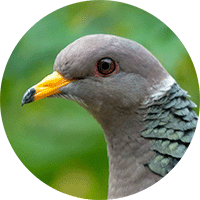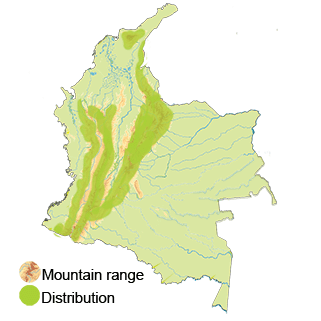Southern Band-tailed Pigeon
The Southern Band-tailed Pigeon (Patagioenas albilinea). Read in Spanish
Appearance: The Southern Band-tailed Pigeon is a medium-sized pigeon. It typically has a dark blue or gray plumage and a prominent white band across its tail. The species also features a white patch on its throat and a pale pink or grayish ceres (bare fleshy area around the nostrils). Both sexes generally have similar plumage.
Habitat: Southern Band-tailed Pigeons can be found in montane forests, cloud forests, and other wooded areas at higher elevations.
Behavior: These pigeons are known for their strong, direct flight and are often seen flying in small to medium-sized flocks. They feed on a diet that includes fruits, seeds, and occasionally insects. Southern Band-tailed Pigeons are generally quiet birds but may produce soft cooing sounds.
Breeding: The breeding season for Southern Band-tailed Pigeons may vary depending on the location and environmental conditions. They usually build their nests in trees, with both parents sharing incubation duties and caring for the young. The female typically lays one or two eggs per clutch.
Conservation Status: The species is not considered globally threatened and is often regarded as of least concern on the IUCN Red List.
Distribution
The Southern Band-tailed Pigeon (Patagioenas albilinea), also known as the Band-tailed Pigeon or Mountain Pigeon, is a species of pigeon found in various habitats in Colombia.
Andean Region: The Southern Band-tailed Pigeon can be found in the Andean region of Colombia, which includes the Central Andes, Eastern Andes, and Western Andes mountain ranges. These pigeons typically inhabit montane forests, cloud forests, and high-altitude areas with dense vegetation and a mix of trees that provide food resources such as fruits and seeds.
Cauca Valley and Inter-Andean Valleys: Within the Cauca Valley and other Inter-Andean valleys of Colombia, the Southern Band-tailed Pigeon may occur in lower altitude habitats, including forested areas, agricultural lands, and river valleys. The species may also venture into cultivated areas near human settlements in search of food, making use of a variety of plant species for sustenance.
Central Andean Cordillera: The Central Andean Cordillera, encompassing regions like Bogota and the surrounding areas, provides suitable habitat for the Southern Band-tailed Pigeon, especially in areas with moderate to high elevations. These pigeons may be encountered in oak and pine forests, as well as in disturbed habitats near forest edges or clearings.
Northern Andes and Sierra Nevada de Santa Marta: In the northern Andes region, including the Sierra Nevada de Santa Marta, the Southern Band-tailed Pigeon can be found in upland forests and foothill areas. This species might frequent subtropical and tropical zones, utilizing a diverse range of plant species for food and roosting sites.
Eastern Andes and Orinoco Basin: The Eastern Andes and Orinoco Basin regions of Colombia offer suitable habitats for the Southern Band-tailed Pigeon, where it can be seen in montane forests, foothill forests, and areas adjoining riverine habitats. These pigeons may also occur in fragmented landscapes, secondary growth forests, and mixed-species flocks with other pigeon species.
Taxonomy
The Southern Band-tailed Pigeon (Patagioenas albilinea)
- Kingdom: Animalia
- Phylum: Chordata
- Class: Aves (Birds)
- Order: Galliformes
- Family: Odontophoridae
- Genus: Patagioenas
- Species: Patagioenas albilinea
Vocalization
The Southern Band-tailed Pigeon (Patagioenas albilinea), also known as the Band-tailed Pigeon or Mountain Pigeon, is a species of pigeon found in various habitats in Colombia and across the Americas.
- Advertising Calls: Southern Band-tailed Pigeons are known to produce a distinctive deep, mournful, and somewhat owl-like hooting sound that is often described as "who-cooks-for-you" or "who-cooks-for-you-all." This hooting call is a characteristic feature of their vocal repertoire and is commonly used for advertising territory, attracting mates, and establishing social bonds within the flock.
- Contact Calls: These pigeons also use softer cooing or purring sounds as contact calls to maintain communication within the flock or among mates. These gentle vocalizations help in coordinating movements, foraging activities, and reinforcing social connections among group members.
- Breeding Calls: During the breeding season, Southern Band-tailed Pigeons may exhibit more elaborate and rhythmic vocalizations as part of courtship displays. These calls can be accompanied by visual behaviors such as display flights, bowing, and puffing up of feathers to attract potential mates.
- Alarm Calls: When sensing danger or potential threats, Southern Band-tailed Pigeons may emit rapid, repetitive alarm calls that are sharper and higher-pitched than their usual vocalizations. These alarm calls serve to alert other pigeons in the vicinity and prompt a coordinated response to perceived dangers.
- Flight Calls: In flight, Southern Band-tailed Pigeons may produce whistling or clapping sounds with their wings, especially during takeoff or landing. These flight calls help maintain group cohesion, signal changes in flight direction, and coordinate aerial movements within the flock.





